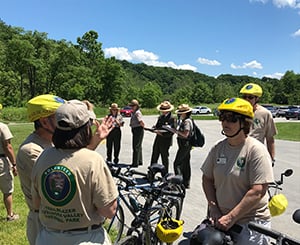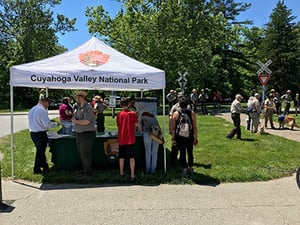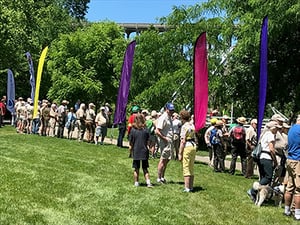Published: July 2, 2019
 The modern environmental movement started taking shape early in the 1960’s. But it came to national attention about 50 years ago, on June 22, 1969, when the Cuyahoga River burned for the last time.
The modern environmental movement started taking shape early in the 1960’s. But it came to national attention about 50 years ago, on June 22, 1969, when the Cuyahoga River burned for the last time.
Many of us remember that event, and how it defined Cleveland’s reputation for many years. Time Magazine covered the story and published a memorable image of the burning river, which likely caught fire after a spark from a passing rail car ignited an oil slick. But from adversity comes positive change.
Cleveland’s mayor at the time was Carl Stokes, the first African-American mayor of a big city. The next day, Mayor Stokes took a group of reporters to the river to talk about the need for clean water legislation. He later testified before Congress about big cities' struggles to stop polluters and advocated for federal legislation along with his brother Louis Stokes, who joined Congress in 1969.
The burning Cuyahoga and other notable environmental events helped focus attention on the need to protect and restore our waterways. Many say this inspired the creation of the Environmental Protection Agency and the passage of the federal Clean Water Act of 1972.
Related: A New Guidebook to Cleveland's Thriving Restaurant Scene>>
50 Years Later: A River Reborn
The Cuyahoga River fire endured for decades as a symbol of our poor treatment of the environment. But much has changed in 50 years. Local park systems, along with the Cuyahoga Valley National Park, have protected the river and taken steps to restore it to a vibrant habitat for fish and wildlife, as well as an increasingly popular water trail. Thinking back 50 years, the recovery of the Cuyahoga River is genuinely remarkable when considered in contrast to the fire.

Today, you can bike, hike and even paddle along the meandering river. The scenery will vary from parks nestled in the industrial heart of Cleveland, to the peaceful natural countryside that can be seen throughout the national park. By the way, “Cuyahoga” is translated from a blend of native peoples’ languages to mean “crooked river.”
All of this is contributing to Cleveland’s burgeoning tourism business, as noted recently in an article by The New York Times. And this year, the river that once burned has been named River of the Year by a national conservation advocacy organization, American Rivers. We’ve come a long way.
Related: America's Treasured Places: Our National Parks>>
Environmental Facts Highlight Restoration Efforts
A recent article in FreshWater Cleveland highlighted 50 reasons why the Cuyahoga River is special. Here are just a few that relate to the environmental change that we are celebrating this year:
- The Cuyahoga River is relatively young, only about 13,000 years old. It is still considered an “infant glacier river” in the U.S, among those carved out by a retreating glacier.
- Dozens of new species of fish and macroinvertebrates have been discovered in the river just in the past decade.
- December 18, 2018, saw restrictions on fish consumption from the river removed by the EPA.
- The great blue heron, the largest heron in North America, is making a strong comeback due to river conservation efforts.
- The Cuyahoga is moving ever-closer to designation as an official Ohio Water Trail. Once the Brecksville Dam is removed (planned for 2019) and later, the Gorge Dam in Cuyahoga Falls (2023), the river will flow freely for fish to swim and kayakers to paddle.
Regional Activities Celebrate the Cuyahoga River Today
All this good news calls for a celebration. This summer, hundreds of local arts and environmental agencies are collaborating to recognize the Cuyahoga River’s rebirth. From downtown eateries to the national park to Summit County, there are plenty of events to commemorate and celebrate the river.
 The pinnacle weekend for the celebration was June 19 to 23 – the 50th anniversary of the last fire was June 22nd – with several special events. The Xtinguish Torchfest saw the passing of a lighted torch 100 miles, over 3 days, from the headwaters of the Cuyahoga River (in Geauga County) to Cleveland’s Rivergate Park. People celebrated all along the way.
The pinnacle weekend for the celebration was June 19 to 23 – the 50th anniversary of the last fire was June 22nd – with several special events. The Xtinguish Torchfest saw the passing of a lighted torch 100 miles, over 3 days, from the headwaters of the Cuyahoga River (in Geauga County) to Cleveland’s Rivergate Park. People celebrated all along the way.
The Cuyahoga Valley National Park had music, poetry and the dedication of a new statue to see the torch to its final destination in downtown Cleveland. Other events included: Blazing Paddles, a stand-up paddleboard race, canoe and kayak celebration of the river; a lighted boat parade; and then the popular Burning River Fest was back for its 18th year of music, craft beer and community.
Festivities will continue through the summer, culminating with the Sustainable Cleveland 2019 Summit in October.
Plan Your Next Adventure Today
Are you wondering what else the surrounding area has to offer? Check out the guide, “Planning Your Next Adventure” for a list of 10-must-see National Parks, close-to-home getaways, and more.
Free Guide: Planning Your Next Adventure: Must-Sees and Travel Tips
In this guide you'll get 5 close-to-home getaways, 6 college towns you never thought to visit, 10 must-see National Parks, 6 road trips, booking tips and more!




